50 great films you (probably) haven't seen

Stuck for something to watch that isn’t the 10,000th showing of Cool Runnings on BBC Two? Here, in alphabetical order, are 50 of the greatest films you probably haven’t seen. Some you will have heard of, others not so much. But all are movies that exist somewhere off the beaten track, either by narrative choice, or by the cruel hand of fate...
1. American Heart (1992)
Filmmaker Martin Bell, several years before American Heart, directed the landmark documentary Streetwise, about a ragtag group of homeless children living on the streets of Seattle. American Heart lifts from the same well of emotional power, with Jeff Bridges attempting to work, make clean money and stay out of trouble following a stint in prison for robbing a jewellery store.
At the same time, Bridges’s character reunites with his son (Edward Furlong), a 14-year-old boy already accustomed to tragedy and parental isolation, and attempts to keep him on the straight and narrow alongside him.
In many ways American Heart is a traditional weepie, driven by men existing on the fringes of society eagerly trying to make a better life for themselves. But it is made particularly powerful thanks to its performances, along with a soulful soundtrack provided by Tom Waits.
2. A New Leaf (1971)

Unsparingly nihilistic and completely hilarious as a result, Elaine May’s A New Leaf exploits toxic masculinity for giggles, with Walter Matthau’s grouchy bulldog of a face reaching comic heights of petulance as a layabout heir who is told there is no money left in his trust fund. That leaves him with just two options: either end his own life, or marry a clueless heiress that he can kill on their honeymoon. Being a monster, Henry chooses the latter option, wooing a hopelessly ungainly (and secretly wealthy) botanist played by May.
Along with being a blueprint for May’s unique brand of incredibly dark humour and world-weary feminism, A New Leaf is also a fascinatingly rare starring role for the veteran comic.
3. An Unmarried Woman (1978)
The late Jill Clayburgh is one of the forgotten leading ladies of the Seventies, having stepped out of the limelight just as women like Meryl Streep and Susan Sarandon began their ascent. Which is why it’s easy to overlook An Unmarried Woman, Paul Mazursky’s era-defining drama that cast Clayburgh as a 40-something wife and mother whose life is upturned when her husband leaves her for a younger woman. It’s the stuff modern romantic dramas have turned into cliche, but that here feel anthropological and fascinating.
4. Baby Boom (1987)

Baby Boom is nobody’s choice for Diane Keaton's most iconic role, but it remains a star vehicle of impressively innate likeability. Keaton is the power-suited yuppie whose life and career is upturned when she discovers a distant cousin has, in death, left her baby daughter to Keaton in her will. Traditional baby comedy ensues, along with shady business dealings via an irresistibly snidely James Spader, and a potential new business venture and boyfriend for Keaton in the form of a homespun veterinarian played by Sam Shepard. Despite a premise that indicates a minefield of potential issues, Baby Boom ultimately smart and endearing, devoid of the political ickiness that makes so many Eighties comedies uncomfortable to watch today.
5. Barfly (1987)
Mickey Rourke is almost too perfectly cast as one of America’s most famous drifters, the gruff star here playing a variation on Charles Bukowski. Barfly is deliberately repetitive as a result of its star, capturing the boozy cycle of drinking, fighting, writing and pontificating, before falling asleep somewhere and starting the whole day over once again. It’s also visually flawless, director Barbet Schroeder crafting a neon smorgasboard of dirty bars, garish lighting and Skid Row grime.
6. Bowfinger (1999)
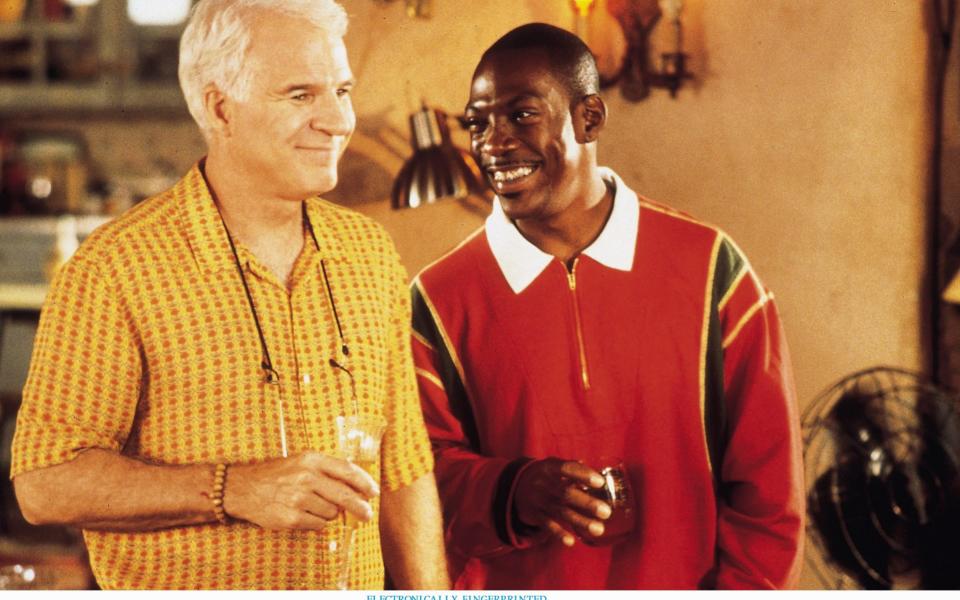
There are two kinds of Hollywood satire: those that are so insular in their worldview that they’re completely alienating, and those that aren’t. Bowfinger, Steve Martin’s only-slightly-bitter condemnation of the industry that birthed him, is very much the latter, with the actor writing and starring in a wacky farce driven by the idea of where he likely would have ended up if he had never become famous.
Martin is a chronically unsuccessful filmmaker who decides to trick world famous actor Kit Ramsey (Eddie Murphy) into appearing in his sci-fi epic Chubby Rain through the use of guerilla filmmaking and a body double in the form of his goofy twin brother Jiff (also Murphy). Bowfinger is one of those big studio comedies of the Nineties that people forget is quite as good as it is, a film both celebrating of an industry comprised of starry-eyed dreamers, and deeply cynical about its shallowness. It’s also arguably cinema’s greatest use of Eddie Murphy, which is impressive in itself.
7. Bug (2006)
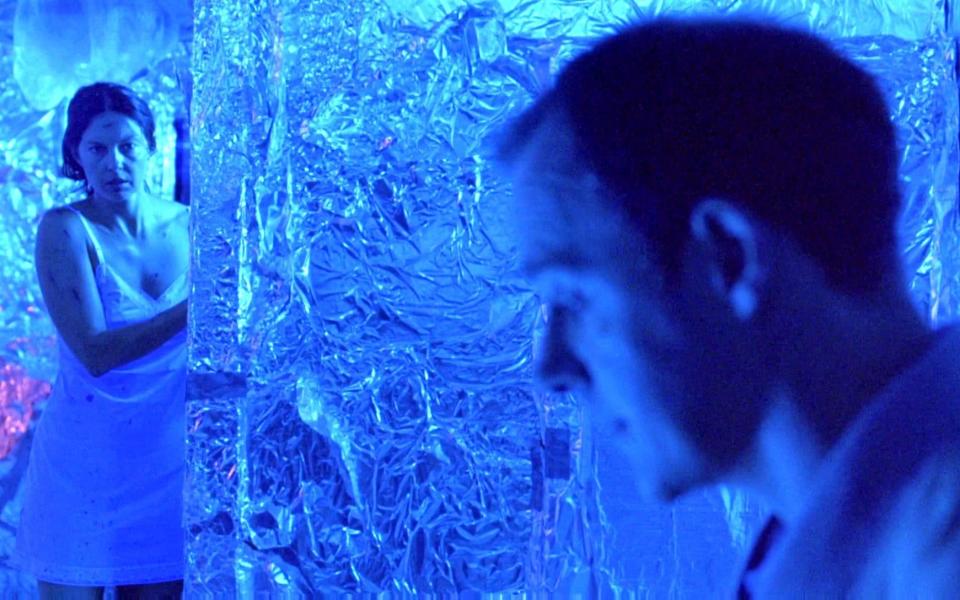
Based on a play by Tracy Letts, William Friedkin’s terrifyingly prescient Bug stars Ashley Judd as an isolated woman living in a trailer park, her young son dead and her abusive ex husband stalking her over the phone after being released from a stint in jail. Entering her life one night is Michael Shannon’s paranoid loner, whose delusions about bugs under the skin grow increasingly more manic and far wider in scope.
Watched in an era of Pizzagate and 4Chan, there’s something enormously frightening about the rabbit holes Judd and Shannon travel down while awash in paranoia, pulling at random threads and coincidences to create delusional theories about child abduction, government surveillance and UFOs. Friedkin may have been responsible for The Exorcist, but Bug is truly his horror masterpiece.
8. Clean, Shaven (1993)
Many great American films from the early-Nineties indie boom vanished without a trace, but that Lodge Kerrigan’s Clean, Shaven was one of them won’t come as a surprise to anyone who has seen it. A difficult, unwieldy thriller about mental illness, self-harm and everyday cruelty, it stars Peter Greene as a schizophrenic recently released from an institution and eager to reunite with his young daughter.
There is a murder, a detective and what seems to be a gun hidden in the glove compartment of a car, but Kerrigan keeps the noir plotting at a remove – instead we exist almost entirely in Greene’s head, his sickness embodied in white noise and extreme close-ups. While not for the faint of heart, Clean, Shaven is an unheralded masterpiece.
19. Close My Eyes (1991)
One of those “love him or hate him” playwrights, Stephen Poliakoff’s work usually revolves around the same themes: wealthy broken families, modernist architecture, stoic misery. And Close My Eyes, his 1991 feature film, is no different, but it does feature interesting insight into the material wealth and social tragedy of the late Eighties, with characters turning to selfish excess in an attempt to avoid looking at AIDs or the trampant inequality of the era. Also there’s lots of incest.
Clive Owen and Saskia Reeves are siblings Richard and Natalie, whose long separation is brought to a close in adulthood, only for both of them to embark on an incestuous affair behind the back of Natalie’s husband, a detached man played with unsurprising chilliness by Alan Rickman.
9. Crimes of Passion (1984)
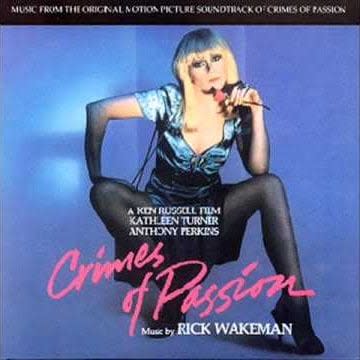
Ripped to shreds by critics upon release, Ken Russell’s Crimes of Passion is the neon-soaked sexploitation love story you didn’t know you needed in your life. Those familiar with the Russell ouvre will find little surprising about the tonal whiplash he encourages throughout, with Kathleen Turner starring as a prim fashion designer by day and a bewigged dominatrix call girl by night. Among the men bewitched by her include an all-American family man eager to explore his sexuality, and a deranged reverend (Anthony Perkins) who wants to have sex with her as much as he wants to exorcise her.
Crimes of Passion drips with sleaze, with all the grisly thrill of a back-alley, sticky-floored nightclub, and carves out its own almost cartoonish sensibility. Characters fling insults at each other like they’re on an X-rated Aaron Spelling soap, while the stalk-and-slash subplot involving a serial sex killer is straight out of the Dario Argento playbook. And Turner goes for it with unabashed ease, tackling kinky sex and graphic sadomasochism as if it’s just another day at the office. This is one to be seen to be believed.
10. Deadlock (1970)
A German western shot in the Israeli desert and depicting a post-apocalyptic wasteland straight out of Mad Max, Deadlock lifts from the best of Sergio Leone while injecting doses of Sixties psychedelia to the mix, creating an underrated foreign oddity worthy of greater attention. Marquard Bohm (looking like a young Mick Jagger) is the petty criminal wandering the desert with a briefcase full of cash. Anthony Dawson is the man he’s indebted to, and Mario Adorf is the old miner who intercepts their meeting.
11. Def by Temptation (1990)
Outside of blaxploitation and a hopeful resurgence sparked by Get Out, there have been relatively few horror movies directed by black filmmakers, which leaves experiments like 1990’s Def by Temptation as enjoyable genre outliers. A Troma production, with all the hammy acting and low-budget scenery that that promises, James Bond III’s sole directorial effort is a goofy morality tale and a Cronenberg-aping thriller featuring a man getting eaten by a TV. Featuring an all-black cast and a cameo from a pre-fame Samuel L Jackson, Def by Temptation isn’t necessarily a good movie, but its sheer uniqueness and verve (its cinematographer is long-time Spike Lee collaborator Ernest Dickerson) make it an unexpectedly important film in the horror canon.
12. Defending Your Life (1991)
If you’re a fan of The Good Place, you might want to check out Defending Your Life, another wacky take on the afterlife, where heaven and hell as we know it have been replaced by a bureaucratic, nightmarish version of Los Angeles, in which the recently dead must legally defend their own choices in life in order to reach utopia.
Albert Brooks, that patron saint of miserabilist American comedy, writes, directs and stars, in a film that features a goofy, Simpsons-style cynicism, but also an abundance of heart.
13. Demonlover (2002)
George W Bush appears on a TV screen midway through Olivier Assayas’s Demonlover, and it’s the only pure indication that this was released in 2002. Otherwise there is a terrifying present-day relevance to this ice-cold techno thriller, with Connie Nielsen as a corporate spy working multiple sides in a deal revolving around 3D manga pornography.
Gina Gershon and Chloe Sevigny make the other two thirds of the film’s central triangle, all representatives of different business entities and eager to prove their cutthroat worth. The story eventually spirals out of Parisian boardrooms and onto the dark web. This is a dark, ponderous film, with a sharp left-turn in narrative that fragments the story and immediately brings to mind Mulholland Drive as a result.
14. Dick (1999)
Dick, in principal, sounds like a one-joke comedy: what if the “Deep Throat” that led Woodward and Bernstein to bring down Nixon was in fact two daffy teenage girls, who unintentionally stumbled their way into an array of criminal revelations while on a White House tour? In execution, Dick is a masterpiece, a farcical satire of political cinema and the almost cartoonish corruption of the Nixon administration, and one brought to life by a wonderfully dim-bulb Kirsten Dunst and Michelle Williams, both dressed to the nines in stars-and-stripes polyester duds.
15. The Family Fang (2015)

In the pantheon of cinematic siblings, few would expect Jason Bateman and Nicole Kidman to have any sort of chemistry together, let alone the sort that could convey decades of brother/sister angst. But their sparkling, believable back-and-forth is just one of the many surprises in The Family Fang, a forgotten indie from just a few years ago that scored mixed reviews and an uneventful US theatrical release before landing on DVD in the UK.
Directed by Bateman himself, this funny, tragic tale of family dysfunction sees him and Kidman play the only children of a pair of conceptual artists (Christopher Walken and Maryann Plunkett) who suddenly vanish without a trace. And while both siblings argue over whether their parents have merely enacted the latest in a long line of morally dubious art projects, they scratch at old wounds, resurrecting the pain they previously thought had been put to bed.
33. Festival (2005)
An attempt to transfer the scattershot ensemble comedy of Christopher Guest to UK shores, Festival is a dark, merciless satire set during the Edinburgh Fringe, with a host of familiar faces (among them Stephen Mangan, Chris O’Dowd and Matthew Holness) playing comedy world archetypes, from the delusional up-and-comer to the avant-garde Canadian with the unbearable multimedia dance show.
The funniest, however, is underrated comedy treasure Lucy Punch, playing a monstrous North London blonde with no actual comic timing or funny gags, but whose looks and marketability make her the breakout star of the festival. Director Annie Griffin made her name in acidic, polarising TV like Channel 4’s cult comedy The Book Group, and Festival is very much in that wheelhouse.
16. Der Fan (1982)
Playing like one of those melodramatic One Direction fandom op-eds from 2013 gone horribly wrong, Der Fan (aka Trance) is a drum-tight German horror about pop star obsession, with the enchanting Désirée Nosbusch as a teenage girl hopelessly infatuated with a Gary Numan-esque musician. She writes him fanmail, listens to his songs ad nauseum, and speaks of the loneliness and sadness in his eyes that apparently only she can see.
Before Dr Freud can shriek “projection”, the girl sets out to meet her idol, but their interaction quickly turns from fantasy to grisly horror, with Nosbusch’s actions making the unsettling behaviours of the anti-heroes of modern horror films like Raw and Hard Candy look like kindergarten stuff.
17. Freeway (1996)
Reese Witherspoon fans will often look to Election’s Tracy Flick or Legally Blonde’s Elle Woods as the peak of her cinematic powers, but true Witherspoon completists will recognise the gonzo little indie she made a few years prior to both. In Freeway, a kind of Little Red Riding Hood on steroids, she is Vanessa Lutz, a potty-mouthed, illiterate trailer trash queen who hitches a ride with a serial killer played by Kiefer Sutherland, winds up in jail, gets molested by an eerily unbalanced Brittany Murphy, and plots her escape to her Grandmother’s house.
18. Friends with Money (2006)
Nicole Holofcener’s films are often relatively plotless, instead capturing small moments in the lives of ordinary women and their circles of family and friends, moments that are often humorous, but more often than not hit a funny-sad sweet spot that has long made her the far more interesting and all-together less ghoulish heir to Woody Allen.
But while she has received widespread acclaim for films like Enough Said and Walking and Talking, her most underrated work is Friends with Money, starring Frances McDormand, Jennifer Aniston, Catherine Keener and Joan Cusack as a quartet of LA friends whose shifting incomes and perpetual melancholy threaten to pull apart many of their relationships. Like much of Holofcener’s work, Friends with Money showcases a group of brilliant actors at the very top of their game (Aniston, in particular, has never been better), but it is McDormand who unsurprisingly steals the show. tr
20. Grace of My Heart (1996)

A collaboration between two of cinema’s most interesting and underused women, actress Illeana Douglas and director Allison Anders, Grace of My Heart pulls from a tapestry of famed female singer/songwriters, among them Carole King and Lesley Gore, to present the quasi-fictionalised tale of Edna Buxton, a songwriter whose career is perpetually on the cusp of fame and recognition, if not for the constant interruption of bad men, unscrupulous industry execs and dashed hopes.
Annoyingly, there is sometimes too much scope, with the film eager to explore numerous different facets of the music industry at once. It’s a curious choice, but when you see how many female filmmakers on this list struggled to get further work made, it’s no wonder Anders and Douglas tried to pack in as much as they could. As a result Grace of My Heart is an enjoyable if raggedy beauty still worth seeing.
21. Guinevere (1999)
Guinevere formed the backbone of one of the many stories to come out about Harvey Weinstein last year, with actress Sarah Polley revisiting an incident in which she was asked to take part in a sexy photo shoot for the film’s promotional poster at Weinstein’s request, and allegedly propositioned in his office shortly after. And it’s a disservice to the film itself that it’s likely the most high-profile reference to it since its minor release in 1999.
Written and directed by Audrey Wells, Guinevere stars Polley as a restless law student named Harper. As an act of rebellion, she embarks on an affair with a middle-aged photographer, Stephen Rea’s Connie, a man with a history of selecting young, vulnerable women to act as his muse.
In the hands of a lesser director (or, you know, a man), Guinevere would likely be bothersome. But Wells allows the story to unfold in all its complicated glory, exploring the inherent imbalance of a May/December romance and the gendered misogyny of “the artist’s muse”, but also addressing the personal and creative growth Harper experiences via her relationship. Jean Smart is also on hand to play Harper’s mother, delivering one of cinema’s most breathtaking monologues as she confronts Connie over his predatory leanings.
22. Identikit (1974)
What, you don’t remember the Italian psychosexual art film Elizabeth Taylor made shortly after divorcing Richard Burton for the first time? Also known as The Driver’s Seat, Identikit is Taylor at her most experimental, starring as an unbalanced American socialite arriving in Rome and searching for a lover to bring her to the ultimate orgasm. Or so we think, with a fractured, ambiguous narrative allowing events to unfurl with Lynchian opaqueness, building to a crescendo of sex and violence.
There’s a lot here to savour over, from Vittorio Storaro’s gorgeous cinematography and Andy Warhol’s baffling cameo, to the threatening undercurrent of political terrorism that hovers over every scene. But it’s Taylor who is most remarkable, showing her teeth with a performance that is prickly, unsettling and brilliantly odd.
23. In the Cut (2003)

Unfairly maligned at the time of its release, for the most part due to the crime of depicting America’s Sweetheart Meg Ryan having lots of graphic sex, Jane Campion’s In the Cut has grown in acclaim in the decade and a half since, critics finally catching up to its sweaty, poetic genius.
Ryan is a New York English professor embroiled in an ambiguous affair with Mark Ruffalo’s NYPD cop, a man she finds equal parts repulsive and arousing in his sexual aggression. There’s also a killer on the loose, who Ryan’s character believes she may have seen hidden in the shadows before he murdered his last victim.
Set during a hazy, yellow-tinted Manhattan summer, Campion’s film is an odd beast, a Brian de Palma-style exploitation thriller very clearly written and directed by women, where themes of sexual agency, naked male rage and female sexual pleasure take precedence, in a way that the genre doesn’t historically allow. It’s incredibly smart, seductive filmmaking, and one of the best kept secrets of 21st century cinema so far.
24. Josie and the Pussycats (2001)
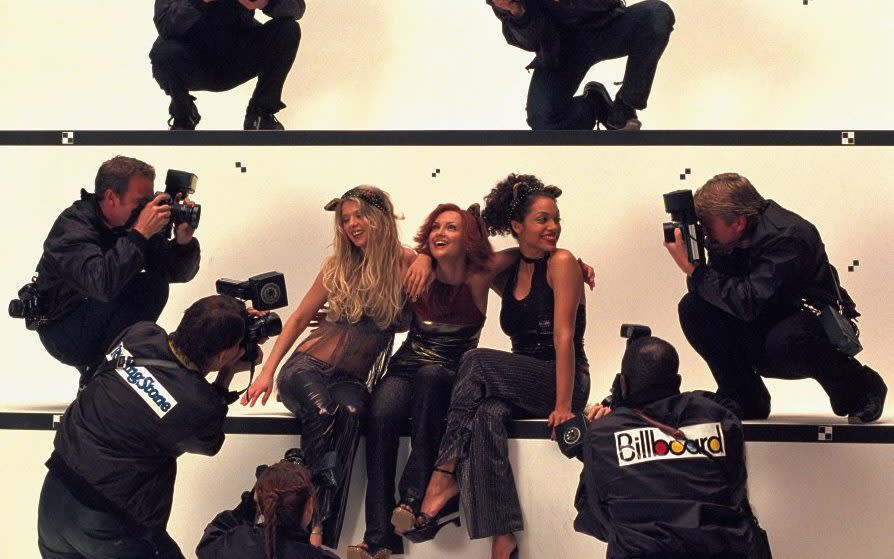
Mismarketed to pre-teen girls and as a result sinking without a trace upon its release in 2001, Josie and the Pussycats is in fact a gloriously cynical satire of the pop music industry, one that may be dated in its references (TRL, CDs and NSYNC are all parodied) but is still unusually relevant in its poking at soulless, mass-produced capitalism.
Based on the Archie Comics characters, Josie and the Pussycats (played by Rachael Leigh Cook, Rosario Dawson and Tara Reid) are a high school garage band plucked out of obscurity by a sleazy record executive (Alan Cumming) to become pop’s next big thing – taking the place of a dim-bulb boyband believed dead after a mysterious plane crash. But excitement quickly turns to misery when lead singer Josie discovers a plot to place subliminal messages in the band’s songs and subsequently brainwash America’s youth.
Knowing, hilarious and full of meta gags, Josie and the Pussycats has rightly become a cult classic off the back of its script, pop-punk soundtrack and shiny, new-millennium visuals, but the film’s secret star is Parker Posey as nefarious record label boss Fiona. A brilliant and criminally underrated comedy.
25. The Lacemaker (1977)
If Isabelle Huppert is France’s Meryl Streep, then this is her Deer Hunter – a performance of rare, captivating depth from a then-unknown, and one that forced an entire generation of filmgoers to sit up to ask, “Just who is that?”
Huppert is the timid, virginal Pomme, an assistant in a hair salon, who experiences life vicariously through her only friend, the sexually uninhibited Marylene. Together they travel to Normandy for a holiday, where Pomme meets and immediately falls in love with a man in his early thirties, whose refined lifestyle revolves around academia and wealth. Things begin romantically, but their differences quickly create a deep and potentially destructive chasm between the two of them. Where The Lacemaker goes from there is best not to know about in advance, but Huppert is remarkable throughout, conveying years of solitude and jilted expectations with very little actual dialogue.
26. Last Summer (1969)
Nearly three decades before Harmony Korine shocked the olds by writing about underage sex and adolescent cruelty in Kids, Frank Perry’s Last Summer addressed the darker side of the hippie generation. Barbara Hershey, Richard Thomas and Bruce Davison are the surfer teens experimenting with sex and violence during a long Fire Island summer, doling out casual cruelty when a meek young woman of particular sensitivity (played by Catherine Burns) interrupts their triangle.
This is brutal and unsparing in its darkness, but equally as impressive in its sheer nerve. That Last Summer earned Oscar attention at the time, with Burns receiving a Best Supporting Actress nod, even more so.
27. Light Sleeper (1992)
Imagine Taxi Driver, only with its grungy Scorsese aesthetic replaced by a stylised art deco opulence, and you’ll have some idea of Light Sleeper, Paul Schrader’s pulpy 1992 drama about a drug dealer for New York’s elite.
Willem Dafoe is the insomniac of the title, whose past addictions and present-day unease collide over the course of a long night in the city. Schrader’s film, however, isn’t necessarily a dour experience. Instead it is oddly alluring, its heightened dialogue and inexplicable soft-rock soundtrack giving Light Sleeper the feel of an extended fever dream.
28. Looker (1981)
Michael Crichton’s forgotten 1981 thriller Looker features a mind-freezing ray gun, supermodel murders, Albert Finney in a pair of protective space goggles and a cheesy, Sheena Easton-style theme song named after the film’s title… Yet it’s played entirely straight.
Much of Crichton’s career was driven by combining futuristic science-fiction with pulp trash, but Looker is his most overtly campy. Finney is the Los Angeles plastic surgeon framed for the murders of several of his patients, all of whom are models working for a strange advertising agency using aesthetically flawless computer-generated women to throw elections and brainwash consumers.
Looker is unsurprisingly deranged, with the look and feel of a more-expensive-than-usual episode of Columbo. But it’s also incredibly entertaining and oddly prescient in its themes, exploring means to manipulate the populace using technology, and the moral conundrum that is the ownership of a person’s image once it’s been scanned into a computer. If only Audrey Hepburn had watched Looker, she may not have ended up flogging chocolate bars long after her death.
29. Love Jones (1997)
The Nineties was a groundbreaker when it came to black cinema, but its most high-profile projects were largely set within urban ghettos, full of violence and poverty, or driven by goofy sex comedy. Then, in 1997, came Love Jones, a talky, irresistibly sexy romance driven by a love affair between two young artists in Chicago: the philosophical poet Darius (Larenz Tate) and aspirational photographer Nina (Nia Long).
Much of Love Jones takes place within cosy apartments and smoky jazz clubs, full of thoughtful young adults talking about love, sex and music. There are certainly plot twists, but the majority of the film is almost static when it comes to narrative, with relationships forming naturally and characters meandering through life. It’s the cinematic equivalent of Janet Jackson’s Velvet Rope album, or the very best of Lauryn Hill – subtle, cool and sexy, but dripping in lived experiences and the realities of black life and love in America.
That writer/director Theodore Witcher never made another film, like so many of the directors mentioned in this list, is another embarrassing Hollywood disappointment.
30. Lao Mao (1992)
More interesting for what it represents than what it actually is, Lao Mao (translation: The Cat) is a solid entry point to Category III filmmaking, Hong Kong cinema’s version of the X rating. Both appropriately gonzo and almost supernaturally entertaining, Lao Mao revolves around a mystical space cat, who is brought to earth by two extra-terrestrial beings to battle a goofy latex monster terrorising the populace.
To put it in a Western perspective, this sometimes resembles a particularly gory episode of Power Rangers, with its neon colours, low-budget pyrotechnics and stilted acting. But it’s so unapologetically surreal, particularly a scene in which the titular cat engages in a lengthy kung-fu battle with a dog, that it’s worth seeking out.
31. La Nuit Des Traquées (1980)
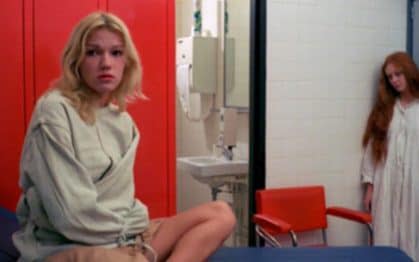
For many, French filmmaker Jean Rollin is one of the best storytellers of modern alienation and camp horror. For others, someone best known for directing a whole lot of softcore pornography. His 1980 film La Nuit Des Traquées (aka The Night of the Hunted) is, true to form, somewhere in between, full of gratuitous nudity and the kind of static-shot romping that is far more funny than it is sexy. But it’s also desperately sad and thoughtful, working as a terrifying metaphor for state surveillance and capitalist drudgery.
Adult film star turned legit actress Brigitte Lahaie is Elysabeth, a young woman introduced mid-escape from a strange health facility, with a memory that lasts only a few minutes at a time. She briefly falls in love with her rescuer, until she is once again re-captured by representatives of the clinic, who imprison her in an office block with a host of other (often young, pretty and permanently naked) women who have also had their minds wiped. While struggling to regain her memories, she plots her escape. A fascinating, unusual landmark in French psychological horror.
32. Paper Mask (1990)
A medical thriller set in an archaic Bristol hospital, Paper Mask touches on class, elitism and the allure of playing pretend, with Paul McGann as a hospital orderly who assumes the identity of a young doctor and begins treating patients. Directed by Christopher Morahan, it’s a film that often lurches haphazardly between genres, unsure if it wants to be a straight drama or a horror movie, but McGann is fascinating to watch on screen, as is his combustible chemistry with Amanda Donohue, playing the doctor love interest who begins to spot cracks in his facade.
34. Psycho Beach Party (2000)
Quietly released at the tail end of the Nineties slasher movie boom, Psycho Beach Party has all the hallmarks of a Scream clone, from its cast of TV actors (among them stars of Buffy the Vampire Slayer and Sabrina the Teenage Witch) and its self-referential tone to an appearance by a future Oscar nominee (Amy Adams!) But it’s also the work of legendary drag performer and playwright Charles Busch, meaning there’s a lot more to it than meets the eye.
In what amounts to a genre-bending spoof of Sixties surfer movies, Lauren Ambrose (of Six Feet Under fame) is Chicklet, an aspiring wave rider whose girl-next-door image masks a foul-mouthed alter ego, and who may also be responsible for a series of grisly Malibu murders. Camp to the extreme, Psycho Beach Party is funny and biting in its technicolour razzle-dazzle, but also never mocks its surf movie lineage.
35. River’s Edge (1986)
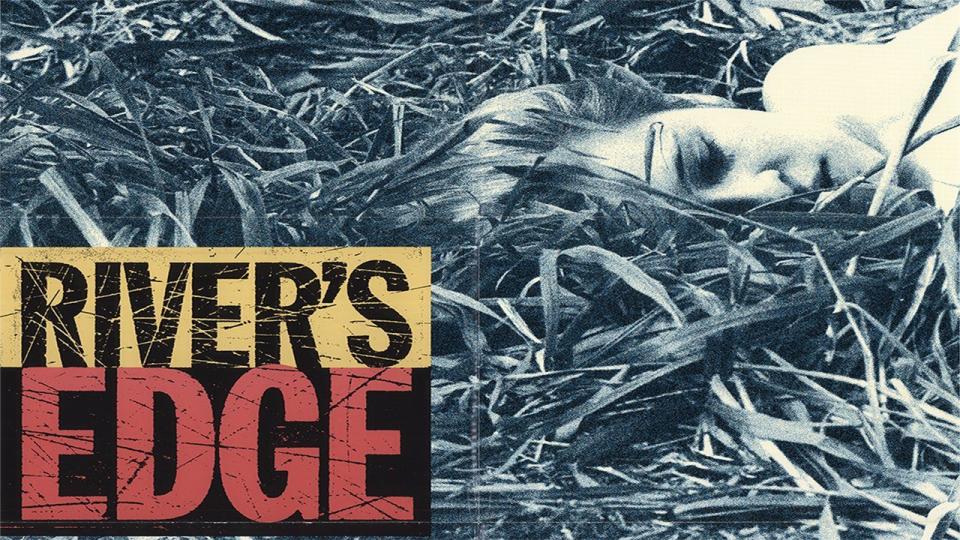
At the time of its release, River’s Edge was criticised for its depiction of teenagers so jaded and troubled that the discovery of a dead girl’s body leads them not to run to the police but instead poke it with a stick and leave it for days. Watched now, the nihilism of the film’s leads is almost quaint. But River’s Edge still unsettles, with Tim Hunter zeroing in on murky themes of small-town repression and adolescent angst.
Keanu Reeves, Crispin Glover and Ione Skye are among an ensemble of kids who discover the body of one of their fellow high schoolers, raped and murdered by one of their own. As the body rapidly decomposes, the group figure out what to do next, while interacting with a number of strange locals who pull them further into darkness.
Much of the conversation around River’s Edge is related to Glover’s wild performance as the group’s resident oddball, but it’s just one aspect of the film that dips its toe into the surreal. It’s no wonder that it’s often cited as a major influence on David Lynch’s Twin Peaks, which shares many superficial similarities, along with director Tim Hunter, who directed several episodes.
35. Roger Dodger (2002)
That Dylan Kidd made his directorial debut with Roger Dodger before largely falling out of the business is one of the great injustices of 21st century independent filmmaking. Because Roger Dodger is a masterpiece – a talky, uncomfortable and completely seductive exercise in male self-loathing and the difficulties of coming of age, with a career-best performance by Campbell Scott.
Scott is the titular Roger, an ad exec with specific opinions about the differences between men and women and how to woo the opposite sex, wisdom he intends to impart to his 16-year-old nephew Nick (Jesse Eisenberg), who arrives in Manhattan eager to experience sex for the first time. But Roger is also a depressed dinosaur, his beliefs endlessly challenged by the likes of Isabella Rossellini’s dominating boss and sometime girlfriend and, in a wonderful cameo, Jennifer Beals and Elizabeth Berkley as two women the pair encounter in a bar.
There’s a lot of walking and talking in Roger Dodger, characters cynically dissecting sex and gender dynamics and relationships, but it’s also often heartfelt and tender when it diverts away from the tragedy of Scott’s protagonist.
36. Scissors (1991)
Of the many thrillers to lift from Roman Polanski’s Repulsion, few talk about Scissors, a 1991 thriller that saw Sharon Stone, a year off from Basic Instinct, getting her Catherine Deneuve on. And that’s not entirely surprising, as Scissors is constantly just on the cusp of actual greatness. But it is an unusually creative exercise in psychological torment, with Stone superbly manic as a damaged woman in peril.
A year after being attacked in an elevator by a man wielding a pair of scissors, Stone’s haunted Angie Anderson becomes romantically involved with a pair of twins, one far more dangerous than the other, and is then tricked into visiting a mysterious apartment. Once inside she discovers she can’t get out, her only company being a collection of creepy dolls, a dead body in the bedroom and, quite naturally, a caged raven who repeatedly insists she’s a murderer. Full of whodunit mystery and pulpy terror, Scissors is one of the best early-Nineties Sharon Stone thrillers.
37. The Sender (1982)
A rare star vehicle for character actor Zeljko Ivanek, who you’ll recognise from at least something if you pull him up on Google Images, The Sender was released amongst a raft of films exploring psychological dream terror, including Altered States and A Nightmare on Elm Street, and delivers as a sleepy, often surreal medical chiller. Ivanek is a suicidal young man taken into the care of a mental institution, where doctors soon discover that he has developed an ability to turn nightmares into reality. Despite its premise, The Sender is very much a slow-burn. But the scenes in which Ivanek’s character demonstrates the might of his telepathic strength, sending doctors flying and blood exploding out of people’s necks, are terrifying.
38. Shampoo (1975)
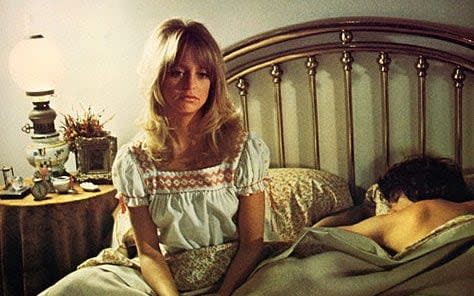
Set on the eve of Richard Nixon’s presidential victory but released in the midst of Watergate-era political scandal, Shampoo satirises the corrupt ebbs and flows of the era, where lying, stealing and infidelity bubbled under the surface but were rarely spoken about. At the same time, Shampoo is also an enormously funny sex comedy, with Warren Beatty as a California hairdresser embroiled in multiple affairs (his conquests including Goldie Hawn, Julie Christie and a luminous Carrie Fisher in her film debut) and discovering the negative side effects of resting your entire future on a man whose wife and daughter you’re both sleeping with.
39. The Shout (1978)

Like The Wicker Man before it, The Shout is another British horror film from the Seventies revolving around ephemeral mysticism, and likewise creates an almost unbearably tense atmosphere through sound and performance.
Alan Bates is the mysterious third party intruding on the relationship of dull marrieds John Hurt and Susannah York, who claims that he has developed black magick powers while living overseas. Included in the powers is the supernatural shout of the title, which he claims can kill anyone who hears it.
The Shout dispenses with standard exposition and linear storytelling early on, the film unfolding in flashback, but pulses with a sustained threat.
40. Sleepwalk (1986)
Delightfully rough around the edges, Sleepwalk is a surreal precursor to the New York arthouse boom that would birth Nineties auteurs like Hal Hartley, Adrienne Shelly and Todd Solondz. Unfortunately, this remains director Sara Driver’s sole feature film, its cinematographer Jim Jarmusch long surpassing Driver’s minor fame on the New York art scene. But what a film it is – Suzanne Fletcher is the young Manhattan office drone tasked with translating an ancient Chinese text, the events it describes then bleeding into her own life. What Sleepwalk lacks in answers it makes up for in its magical surrealism and lived-in pre-Giuliani NY grunge.
41. Smooth Talk (1985)
Joyce Chopra’s 1985 feature film debut Smooth Talk bends genres at will. Its first half is an almost uncomfortably authentic coming-of-age comedy drama, with Laura Dern playing a character at that awkward age in which you want to explore your sexuality, but are also completely terrified at the thought of it. All the while alienating every adult around you. The second half plays like a terrifying thriller, with Treat Williams the much older gentleman caller who leads Dern’s character into a sinister encounter that lies somewhere between fantasy and reality.
Based on a short story by Joyce Carol Oates, Chopra’s film dramatises adolescent girlhood in all its fun, volatility and danger, assisted by a revelatory Dern. In one of her earliest roles, she conveys all the emotional contradictions of youth with just the flicker of an expression change, creating one of the most nuanced portrayals of teenage life in Eighties cinema. It’s just a shame so few people have actually seen it.
42. Star 80 (1983)
There were rumblings about murdered Playboy model Dorothy Stratten upon the death of Hugh Hefner last year, and Star 80, the 1983 biopic about the tragic pin-up, remains the most compelling dramatisation of her short life. Mariel Hemingway is Stratten, the wholesome beauty whose body and soul is packaged, marketed and sold by an array of abusive men, most of all her husband Paul Snider, the jealous, irrational sociopath who ends up killing her.
After several decades chronicling song and dance on film, Star 80 was a fascinating last project for director Bob Fosse – a film that acts as much as a true crime tale as it does a cautionary tale for those looking for fame. And as Snider, Eric Roberts is a revelation, oozing sleaze as one of cinema’s most believable boogeymen. It’s baffling in hindsight that his career became so magnetised to the DVD bargain bin.
43. The Station Agent (2003)

Before Game of Thrones rocketed him to international stardom, Peter Dinklage made his name in a series of small-scale indies, most notably Thomas McCarthy’s The Station Agent. He plays Fin, a loner working in a hobby store with his only friend, its elderly proprietor Henry. When Henry dies, Fin moves to Newfoundland, where he finds unexpected companionship with two equally directionless and lonely people, a food truck manager (Bobby Cannavale) and an artist still recovering from the death of her young son (Patricia Clarkson).
Impactful in its understated simplicity, The Station Agent, like some of the other films on this list, isn’t drowning in plot, but does feature three brilliantly lived-in performances, with McCarthy’s script celebrating the importance of family, whether it’s self-made or not.
44. Things You Can Tell Just by Looking at Her (2000)
Despite the starry actresses he lures to his projects, writer/director Rodrigo Garcia is far from a recognisable name, likely due to the subtlety of his work. Things You Can Tell Just by Looking at Her, inspired by the small-scale short stories of Raymond Carver and the criss-crossing ensembles of Robert Altman, is his first and most assured film, revolving around six interconnecting Los Angeles women immersed in low-key romantic conflict.
Glenn Close is a divorcee in search of spiritual aid, Holly Hunter a woman who falls unexpectedly pregnant, Kathy Baker a single mother in love with her neighbour, Calista Flockhart a psychic with a terminally ill girlfriend, and Amy Brenneman as a doctor who has put her life on hold to help her blind sister, played by a spectacular Cameron Diaz, whose own sex life is thriving.
Each story is told in a short vignette, with characters gently overlapping as the film goes on. Little actually happens, but Garcia’s perceptive, melancholy script is striking in its power, full of gentle humour and touching asides.
45. Triangle (2009)
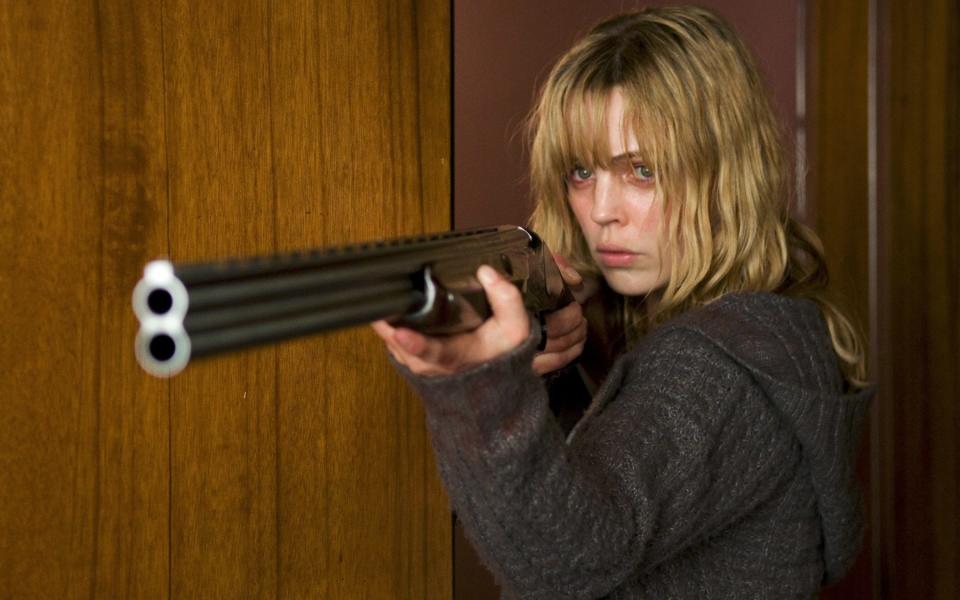
Several years before The Babadook was this other Australian thriller exploring the horrors of the maternal psyche. Sadly there’s no big gay monster here, but there is a very good performance by Melissa George, playing a woman who finds herself reliving the same experiences on an abandoned cruise ship over and over again.
Time loop films are notoriously tricky to mount, but done right they’re irresistible. British director Christopher Smith sprinkles clues and red herrings with careful precision, building to a twisty finale that is as much a tragic testament to parental anguish as it is a ballsy Shyamalanian shocker. There’s a lot more to Triangle than meets the eye, and that’s every bit of its genius.
46. Tyrannosaur (2011)
As unflinchingly brutal as past entries in the unofficial British miserablism movement, among them Nil by Mouth and the works of Alan Clarke, Paddy Considine’s Tyrannosaur is an harrowing, deeply uncomfortable depiction of domestic violence and personal redemption, brought to life by two brilliant performances by Peter Mullan and Olivia Colman.
Mullan is Joseph, a drunk, sociopathic layabout whose encounters with neighbours and associates inevitably end in violence. That is until he meets Colman’s Hannah, a religious charity worker who offers to pray with him. Hannah is being abused by her husband, played by a terrifying Eddie Marsan, and blocking it out with denial and booze. Joseph and Hannah circle one another, each finding solace from the world, but unable to stop it ruining them.
There’s always a lingering question over films like Tyrannosaur as to whether depictions of such horrendous, degrading violence are necessary, when we know things like this happen, and we know that there are numerous people around us existing in cycles of abuse. But Tyrannosaur also reminds us of the damage that occurs when we look away. It is a necessary, terrifying work, and one of the strongest British films of this decade so far.
47. Under the Skin (1997)
No, not that one. But despite the surface differences between this early Samantha Morton vehicle and the surreal Scarlett Johansson sci-fi thriller from 2013, there are several odd connections here and there (from the women’s matching wardrobes to their detached exploration of human sexuality) that make them worthy of a peculiar double bill.
Morton is a young, sheltered woman shaken by her mother’s death and wounded by years of living in the shadow of her older sister. So she breaks up with her long-time boyfriend, dons a wig and a fur coat and indulges in a string of sexual encounters with strange men, pushing the boundaries of what she previously thought herself capable of.
There’s a touch of Breaking the Waves to filmmaker Carine Adler’s first and only feature, but strikingly told through a uniquely female lens. She also gets a wonderful performance from Morton, who in her fragility and inherent oddness delivers what often feels like a test run for her performance in the more widely recognised (and equally brilliant) 2002 film Morvern Callar.
48. Wanda (1970)

One of the most important American films of the 20th century, Barbara Loden’s Wanda is one of the first independent films to be written and directed by a woman. Loden also stars, playing a wife and mother who flees her home to find salvation elsewhere. She meets a bank robber and joins him on the road, demonstrating an infatuation unaffected by his constant belittling, or the dangers of his lifestyle.
As decades have passed, Loden has risked becoming more of a symbol than a filmmaker, based on her fascinating personal story. She made Wanda as a side project while married to a hectoring, controlling man (the filmmaker Elia Kazan), who then expressed resentment when she grew less interested in “housewife stuff” following Wanda’s acclaim. Numerous follow-up projects were mooted, until her career was tragically cut short by a diagnosis of breast cancer, which she fought for eight years before dying at age 48.
Loden lived an understandably compelling life, and one that is in parts still frustratingly relevant today, but it’s important to remember Wanda alongside its late creator. This is a moving, visually gorgeous film, full of tiny disappointments, rural isolation and patriarchal oppression. It’s also so close to the bone in its realism that it often resembles a documentary.
49. Wild Side (1995)

A film more famous for its tragic backstory than anything else, director Donald Cammell having killed himself shortly after filming was completed, allegedly due to Wild Side being taken out of his hands and re-edited by its producers. How much of the tale is urban legend remains something of a mystery, but it only adds to the fantastical allure of Cammell’s final film, a pulp odyssey of corrupt souls, hate-sex and murder.
Anne Heche is a Los Angeles call girl tangled up in a scheme to bring down a money launderer, played by Christopher Walken in a performance that evokes Tommy Wiseau in its bonkers surreality, only to fall in love with his alluring wife Joan Chen. From there, things get inevitably messy.
Pure techno sleaze, Wild Side sees Cammell directing like a madman, capturing interactions with handheld cameras that constantly swoop around his stars, creating a universe that feels as decidedly manic as its inhabitants. Wild Side walks a fine line between glorious eccentricity and pure bad taste, with your opinion on it likely falling somewhere in the middle. But it’s undoubtedly a one-off – sleazy and beautiful, and unlike much else.
50. Year of the Dog (2007)
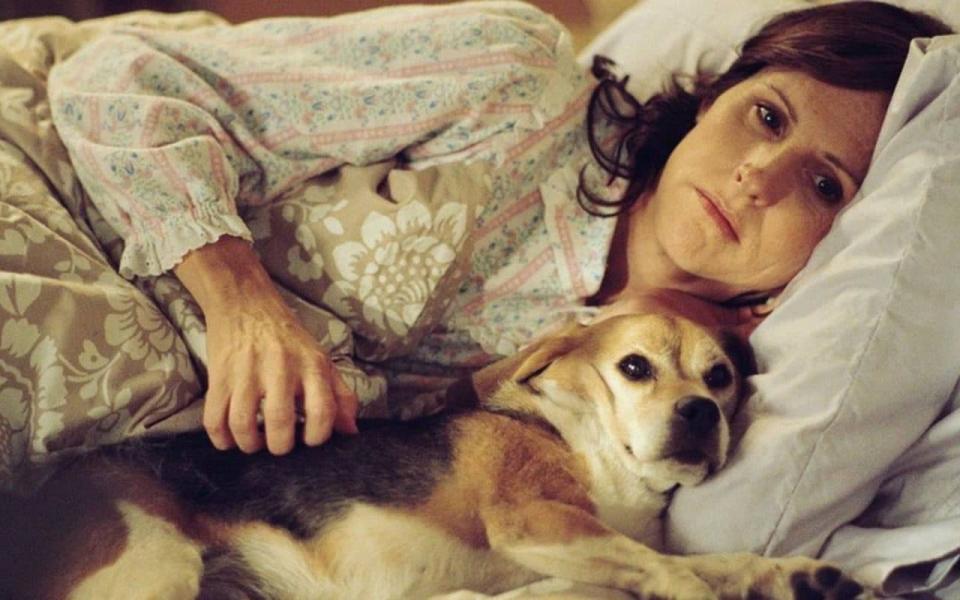
Mike White specialises in writing difficult, polarising protagonists, individuals who are selfish, inappropriate and often one or two cans short of a six-pack. This means that his work, including the films The Good Girl and Brad’s Status and the brilliant Laura Dern HBO series Enlightened, often struggles to find a significant audience.
Year of the Dog, his directorial debut, is case in point. Molly Shannon is the touchy, lonely Peggy, an admin assistant with few ties to actual people, and whose life revolves around her dog Pencil. Then Pencil dies, forcing Peggy to reevaluate her life, leading her to unsatisfying dates and new career paths.
It sounds like the makings of an aspirational comedy. But Year of the Dog is also desperately sad, Shannon sourcing the melancholic pain of a character who alienates everyone she comes into contact with, and who often struggles with basic human interaction despite her best efforts to try and fit in. It’s the sort of film that blissfully refuses to fall back on typical indie-film tropes, with an ending that is a very specific and brilliantly odd kind of happy.

